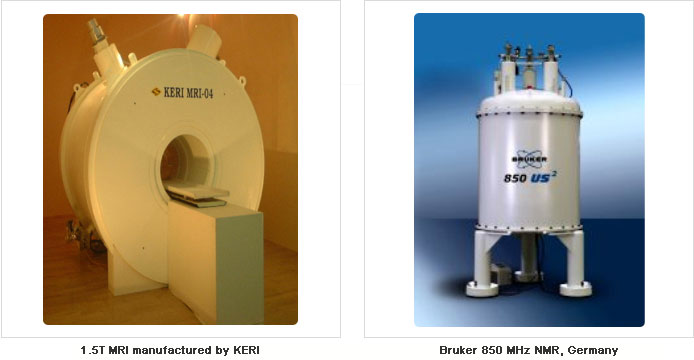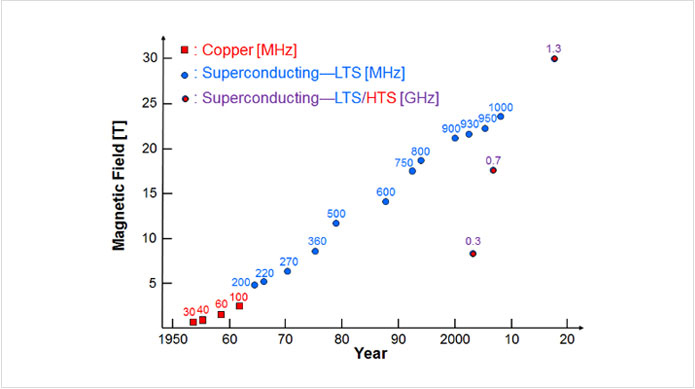
- >
- Superconductivity
- >
- Superconductivity Application Technologies
- >
- NMR & MRI
NMR & MRI
MRI is a magnetic resonance imaging device. The device measures the magnetic properties of materials that make up the human body and re-reconstructs the measurements and provides images through computer.
NMR is a nuclear magnetic resonance device. The device monitors resonances by using magnetic moments of nucleus and magnetic fields applied from outside.
Both the two devices display their performances as a 'Tesla' which is a strength of the magnetic field. The magnetic field strength is a principal element to determine S/N (signal/noise) ratio, resolution, sensitivity, definition, contrast, sharpness, etc. Thus the device is manufactured by using superconducting wire in order to increase the strength of the magnetic field.
Technology for NMR & MRI Superconducting Coil
Coil design and manufacturing, joining for coil interconnection and PCS design and manufacturing for persistent current mode.
Technology for Cryogenic
Cryocooler and cooling facilities manufacturing for superconducting coil cooling, and installation and operation of cooling system.
Technology for NMR & MRI Superconducting Coil Performance Evaluation
Magnetic field distribution measurement and mapping, image signal processing for image construction.
Technology for NMR & MRI Superconducting Coil Correction
Correction coil design and manufacturing and magnetic field correction by applying placement of magnetic material.
Technology for NMR & MRI Insulation
Active shielding using superconducting coils and passive shielding using magnetic materials.
| Technology Characteristics |
Genome Project
As a result of the Human Genome Project (HGP) in early 2003, human genetic map was almost completed (99.99%) and gene's ability was identified based on human genetic map and the structure of a protein created by genetic information was also revealed. Therefore, post-genome research project for actual applications in the treatment and prevention of disease was begun by developed countries, mainly in science and technology, such as United States, Japan, Europe, etc.
NMR(Nuclear Magnetic Resonance)
Researches to identify the accurate crystal structures of the bio-polymer with large investments are actively underway in each country and researches for NMR necessary for identification and analysis of tertiary structure of proteins are also actively underway.
Patients do not have any risks of harmful radiation exposures
The MRI has been using in the diagnosis of breast and gastric cancers in tissue cells, Parkinson, Alzheimer, brain nervous system disorders, etc. since development of MRI in 1985. The MRI has safety advantages when compared with CT or X-ray, because it uses a mechanism of high-frequency and magnetic fields and so patients do not have any risks of harmful radiation exposures.
| Development Trends and their Levels |
MRI
Currently 1.5T MRIs are the most commercially available in domestic and overseas, but 3T MRIs are becoming common with technology advances. the MRI with above 7T field for whole body shot is being developed and brain science researches are being conducted utilizing ovr 7T MRIs in Korea. In University of Illinois, Chicago runs 9.4T MRI for research and France and Germany are jointly developing 11.75T MRI.
NMR
Japan completed the development of 930MHz NMR under the auspices of NIMS and currently is in progress to develop 1.05GHz NMR.
In Europe, Oxford Inc. in Britain and Bruker Inc. in Germany jointly completed the development of 900 MHz NMR and are marketing the products. Recently Oxford Inc. completed the development of 950 MHz NMR and is marketing the products and Bruker Inc. is developing 1GHz NMR. In USA, FBML completed the development of 700MHz NMR and is currently developing 1GHz NMR.

